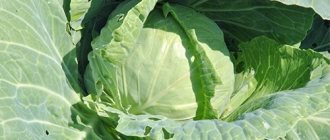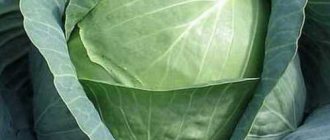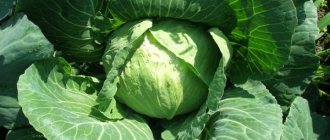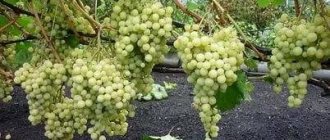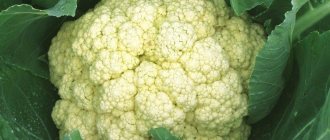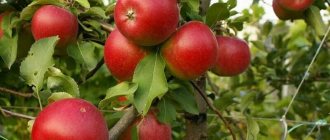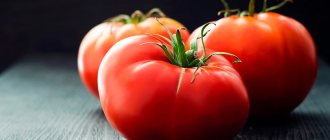- Landing
In recent years, “Aggressor” cabbage has been confidently conquering the garden beds of vegetable lovers. This relatively new hybrid has valuable features - it does not suffer from fusarium, is not afraid of thrips invasion, easily tolerates difficult weather conditions and allows you to obtain a high yield of marketable products with good taste.
Heads of cabbage that ripen in the mid-late period are intended for fresh consumption and the preparation of any dishes, suitable for pickling
A brief description of the “Aggressor” cabbage variety, or rather the hybrid, is given in the table:
| Parameter | Characteristic |
| Culture | White cabbage (Brassica oleracea L. convar. capitata (L.) Alef. var. alba DC.) |
| Variety/hybrid | "Aggressor F1" (first generation hybrid) |
| The period from germination to the beginning of technical ripeness | According to the State Register - 130-150 days; according to the originator – 115-120 days |
| Ripening period | Mid-late |
| Productivity | Marketable – 431-650 c/ha, maximum – 800 c/ha |
| Head weight | 2.5-3 kg (up to 5 kg) |
| Appearance | Medium size, round shape, dense; covering leaves with a waxy coating, have an anthocyanin tint |
| Taste qualities | Good |
| Purpose | Commodity production; used for fresh consumption and processing |
| Shelf life | 3-5 months |
| Sustainability | Resistant to fusarium wilt and thrips damage |
| Year of registration in the State Register of the Russian Federation | 2003 |
| Recommended growing regions | Central Black Earth, Central, Northwestern, North Caucasian, Volga-Vyatka, Lower Volga, Middle Volga, Far Eastern, West Siberian, Ural, East Siberian |
| Originator | Syngenta Seeds BV (Netherlands) |
Characteristics of cabbage
The vegetable acquired its harsh name due to its unique characteristics. The F1 Aggressor is primarily noted for its strong and rapid growth. Also, the variety is not afraid of weeds and has fairly good immunity, which allows it to resist diseases and is rarely infested by insects.
The rosette of the crop is of a raised type. The leaves are round, concave or slightly bubbly, and medium in size. Color – gray-green.
A waxy coating may occur on the surface of cabbage leaves. Depending on the growing conditions, it can be of medium or strong intensity. The edge of the leaf has a characteristic slight waviness.
The head of cabbage is flat-round in shape. If we compare the head of Aggressor with other varieties, it is relatively small: from 2 to 5 kg.
When cut, the vegetable is yellow-white in color.
The variety's planting density on average fluctuates around 35,000 pieces per 1 hectare of planting. Of the harvested crop, about 93-96% can be used for sale. On average, 43-56 tons can be collected from 1 hectare.
The ripening period for Aggressor F1 is 130-150 days.
Breeding history
This crop was sectioned in Holland in 2000. And in 2003, the Aggressor cabbage variety was included in the state register of our country. The variety is recommended for cultivation in the Central region of Russia. The "Aggressor" variety of cabbage is grown:
- in the Central region;
- in Kuban;
- in the Urals;
- in Siberia.
The name of the variety corresponds to the characteristics. The crop is immune to a number of diseases and pests and is characterized by strong and accelerated growth.
Advantages and disadvantages of the variety
Despite the fact that this is a relatively young variety, it has become one of the most cultivated today. The Aggressor managed to achieve this position due to a large number of advantages. In particular, the advantages of Aggressor F1 include:
- Excellent taste.
- Heads of cabbage are not prone to cracking during cabbage storage.
- The leaves are very juicy and crunchy well.
- Aggressor F1 contains a large amount of vitamin C, which makes it possible to include it in the diet of young children or use cabbage as a dietary product.
- High commodity value.
- The aggressor has a powerful root system.
- It can easily be transported over long distances, which makes cabbage attractive for commercial use.
- Aggressor F1 is characterized by uniform harvest ripening.
- The germination rate of seeds of this variety reaches 100%.
- Unlike many other cabbage varieties, Aggressor tolerates short periods of water shortage well.
- Normally tolerates elevated temperatures that occur when cultivating crops in the southern regions.
- It is also not afraid of low temperatures.
- Aggressor F1 is one of the most highly productive cabbage varieties.
In addition, it is worth noting a number of other advantages. Aggressor is a universal variety. Cabbage is suitable for consumption raw; it can be used to prepare salads, stews, etc. In addition, the vegetable can be fermented for the winter.
Typically, heads of cabbage are stored for up to 5 months. Under ideal conditions, the shelf life can be increased to 6-6.5 months.
At the same time, one should not turn a blind eye to the Aggressor’s shortcomings. The disadvantages of this variety include:
- Sometimes heads of cabbage grow with rather hard leaves. These are isolated cases, but alas, they do occur.
- During pickling, an unpleasant bitterness may appear.
- The crop is not protected from aphids and whiteflies.
Peculiarities
The advantages of the Aggressor variety include:
- excellent growth vigor and high yield;
- resistance to fusarium and immunity to cruciferous flea beetle attacks;
- ease of care;
- ability to withstand temperature changes;
- juicy, pleasant taste;
- no tendency to crack;
- unpretentiousness to growing conditions;
- high seed germination;
- good transport tolerance;
- long shelf life.
No objective negative qualities were observed in the variety. However, some gardeners note that the leaves are tough, rough and bitter, which manifests itself when pickling. The listed disadvantages may be a consequence of non-compliance with agrotechnical recommendations. The most serious drawback is that it often suffers from fungal diseases, especially suffering from clubroot.
Aggressor cabbage is one of the most cold-resistant varieties. The possibility of obtaining a harvest under risky farming conditions allows the variety to be cultivated in regions with harsh climates. At the same time, the absence of difficulties in care according to the descriptions of summer residents allows even beginners to get a rich harvest of strong, juicy heads of cabbage, photographs of which can be seen on the pages of gardeners.
Growing cabbage
Growing cabbage is quite difficult. Even unpretentious varieties require more attention than potatoes.
First of all, we select the area where the crop will be grown. You need to choose a sunny place with loose, non-acidic soil. If you grow cabbage in the shade, the crop will “grow” leaves and at the same time almost not form a head of cabbage. Therefore, the issue of illumination must be approached with all responsibility.
Also, it is advisable not to grow cabbage in the place where cruciferous vegetables (cabbage, radishes, etc.) have grown over the past 3 years. The fact is that cruciferous plants have common diseases and insects that affect them. For this reason, if last year your cabbage suffered from a disease, or was constantly attacked by insects, this could happen again this year. Therefore, it is advisable to periodically change the place of growing this crop on your site.
The beds for cabbage are prepared 15-20 days before the start of planting. They are dug up with a shovel or pulled out with motorized equipment. Organic matter is added to them (humus, peat, etc.). Fertilizer consumption is approximately 5 kg per 1 m2.
Seedlings are usually planted in the first half of May. Closer to the North, planting is postponed to the end of May, beginning of June. Cabbage itself is a fairly frost-resistant crop that can survive -5 Celsius. However, this is if we talk about night temperatures. If this temperature remains during the daytime, the plant will most likely die. Therefore, when planting cabbage, you need to rely on temperature conditions.
When planting, use the standard 70x50 cm pattern. Approximately 70 cm is left between rows and 50 cm between plants in a row.
Growing without seedlings
In the Southern regions, Aggressor F1 cabbage can be grown directly from seeds, without prior propagation of seedlings. When planting, standard agrotechnical work is carried out. The only difference is the landing time. If the crop is grown by seeds, then they are planted at the end of April. Add 2-3 seeds to each hole. After the seedlings sprout from them, the strongest is selected from all of them, and the rest are pulled out.
After the seeds are planted, the rows are covered with black film until germination. At this time, the soil is kept in constant moisture, but it is important not to flood it. After the shoots emerge, the film is removed.
Care
All cabbage care is mainly based on loosening, fertilizing, watering and removing weeds.
- Weed removal. Since the crop is constantly watered, weeds constantly grow around it. Yes, the Aggressor is not afraid of weeds even at the initial stage of development, but no matter how you approach it, weeds oppress crops. Therefore, it is imperative to remove weeds.
- Watering. Cabbage is a moisture-loving plant. If there is a lack of water during the growing season, the vegetable will not gain juiciness, the head of cabbage will be small and tough. After planting the seedlings, the soil must be watered every three days. After the seedlings take root, watering is done more rarely, approximately once every 5 days (if the weather is dry, then a little more often).
- After watering, it is advisable to loosen the soil. The lack of oxygen that occurs due to the formation of an earthen crust interferes with the normal development of the crop.
- Fertilizer. In general, if the beds were well fertilized before planting, then no additional fertilizing is carried out. However, in conditions of growing in heavy soil, additional feeding will not be superfluous. The vegetable is fed for the first time 20 days after planting. To do this, add 10 g of saltpeter or urea to 10 liters of water. 200 ml of solution is consumed per plant. The second watering is carried out before the formation of heads of cabbage. To do this, dilute 10 g of potassium monophosphate in 10 liters of water and use about 200 ml of solution per vegetable.
Glory
This variety, consisting of two lines Slava 1305 and Slava Gribovskaya 231, is characterized by very high yields and is excellent for growing in the southern regions. The shape of the heads of cabbage is round or rounded-flat. The external color of the leaves is pale green, and in cross section it is white. The heads of cabbage are easy to transport, they retain their marketable appearance for a long time and are suitable for pickling and pickling.
| Productivity (kg per 1 sq.m.) | Head weight (kg) | Maturation (days) | Storage period (days) | Peculiarities |
| 10-12,5 | 2,5-4 | 110-125 | 90-100 | You need to water cabbage 7-8 times per season. |
Reviews
Larisa Ivanovna, Kyiv, 56 years old.
That season I decided to purchase cabbage seeds of the Dutch selection “Aggressor F1”. Our summer turned out to be scorching; in July-August there was only one rain, and that was light, with sunshine. In addition to Aggressor, I also planted other varieties on the site that I have been growing for many years, namely Turkis, Slava and Atria. The harvest was terrible. There were even specimens that did not produce heads at all. But the Aggressor surprised. I didn't expect such results. There are no heads smaller than 2 kg. All heads are dense, white inside. Despite the dry summer, the leaves are well saturated with moisture and crunchy. It also keeps for a very long time. I have drawn conclusions for myself and this spring I will allocate a larger area for the aggressor.
Dmitry Alexandrovich, Odessa, 43 years old.
I probably grew all the varieties of cabbage that exist in our country. But I have never met a better Aggressor. Seed germination is high, at the level of 95-98%. It doesn’t require much care, just water, pull out the grass and loosen the soil so that it doesn’t get crusty. That's all. But then harvest such a harvest. Heads of cabbage weigh 3-4 kg, smooth, juicy, white inside. We grow Aggressor for sale. For home use only for borscht and kvasim. By the way, it’s ideal for pickling.
How to store?
All harvested crops are sorted. Whole, undamaged heads of cabbage are sent for storage in a basement or cellar. To preserve the crop, the temperature in the storage area should not fall below – 1 °C and not exceed + 2 °C. Cabbage is stacked in rows or hung from slats. The shelf life of cabbage is 5 – 6 months.
Read more about how to properly store cabbage at home in winter here.
There is not only white cabbage, but also broccoli, red cabbage, kohlrabi, Chinese cabbage, ornamental cabbage, cauliflower, and kale. There are also cabbage of different varieties: Megaton, Pak-choi, Slava.
